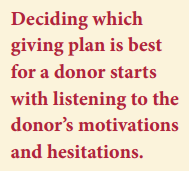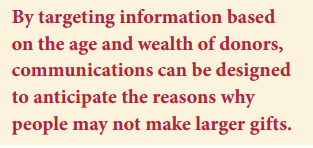Editor’s note: In the December 2012 issue of Give & Take, the first installment of “Why Don’t People Give More?” examined why people who are willing to give only a certain amount may feel they cannot give more. In Part 2, below, Robert Sharpe reveals how a thoughtful development professional can address donors’ concerns while helping them meet their charitable goals.
Deciding which giving plan is best for a donor starts with listening to the donor’s motivations and hesitations. If you have a prospective donor who clearly would make a gift if not for one of the following common fears, consider a number of possible solutions making use of often-used gift planning tools.
The fear: Dying too soon
The solutions: Gifts via the estate, charitable lead trusts
Bequests via will. The most common form of planned gift is a gift by will or will substitute, with the largest bequests typically coming from the residue,  or remainder, of an estate. Because this plan assures that a gift is made only at death and only after specifically providing for loved ones, bequest gifts can appeal to those who are concerned about depriving one or more heirs of economic security. Devoting life insurance proceeds or the remainder of a retirement plan or living trust to charitable purposes can accomplish the same result as a bequest via one’s will while allowing for probate savings and other possible advantages.
or remainder, of an estate. Because this plan assures that a gift is made only at death and only after specifically providing for loved ones, bequest gifts can appeal to those who are concerned about depriving one or more heirs of economic security. Devoting life insurance proceeds or the remainder of a retirement plan or living trust to charitable purposes can accomplish the same result as a bequest via one’s will while allowing for probate savings and other possible advantages.
Charitable lead trusts. Sometimes we tend to place too much emphasis on the gift and estate tax benefits a lead trust can offer. There are actually much more effective ways to pass property to family members. As a result, lead trusts are most often funded by people who want to make significant charitable gifts over time and also wish to provide for their heirs’ future economic security. To such persons, the tax savings are an important factor but not necessarily the primary motivator.
The fear: Living too long
The solutions: Bequests via will, trusts, retirement plans and life insurance; gift annuities, charitable remainder trusts, life estate agreements, charitable lead trusts
Bequests via will, trusts, retirement plans and life insurance. Like those worried about dying too soon, donors concerned about living too long and outliving their resources will often delay a substantial gift until their death so they are assured access to all of their funds.
Gift annuities. This concern can lead others to seek secure predictable income for life through a charitable gift annuity. Deferred gift annuities offer a solution for someone who has adequate income now but worries about needing income in the future.
Charitable remainder trusts. These plans offer many of the same advantages as bequests and gift annuities for those concerned with long-term economic security. The charitable gift is usually deferred until death, but charitable remainder trusts may also be designed to terminate after a specified term of years, at which point funds are transferred to charity.
Life estate agreements. Donors may not realize that they can make a gift of their home now yet continue to live there for the rest of their lives. Transferring the ownership of a home effective at death or after some other specified time, while retaining the right to occupy and enjoy the home for life can offer the donor current tax benefits and probate time and cost savings while also helping maintain financial security.

Charitable lead trusts. A donor who does not need income today but who wants to be able to access principal in the future may be interested in a variation of the charitable lead trust whereby the ownership of funds reverts to the donor at the end of a period of time.
The fear: Illness, economic misfortune
The solutions: Charitable bequests at death, gift annuities, charitable remainder trusts
Charitable bequests at death. As discussed above, bequests also assure access to funds in case of a temporary illness or economic reversal.
Gift annuities. Gift annuities can provide for a steady flow of income for health-related expenses in later life.
Charitable remainder trusts. When a donor transfers assets to a charitable remainder trust, the transfer must be irrevocable to enjoy the tax savings this plan offers. This means the donor would not be able to access the principal if needed. However, it also means no one else, including creditors, can either. For this reason, some people who would not otherwise make a large charitable gift may do so in a way that assures them that no matter what happens, they will always have the income from the trust.
The fear: Mental and/or physical disability
The solutions: Gift annuities, charitableremainder trusts
Gift annuities. Gift annuities provide regular, fixed payments that will continue regardless of the donor’s mental or physical health. This is especially important for those who worry about being able to manage their assets in case of temporary or permanent mental and/or physical disability.
Charitable remainder trusts. Charitable trusts offer more flexibility than gift annuities. They are often used by those who would like to make a large gift and want to ensure that an income is retained in case of disability. Unlike a gift annuity, a charitable trust allows the donor to create a structure that can provide for future increases in the amount received, benefit more than one charitable interest and select the trustee of the funds.
Taxing issues
Any gift, revocable or irrevocable, in which funds are transferred at death can offer estate tax savings. Keep in mind, though, that the vast majority of charitable bequests come from nontaxable estates each year, so tax avoidance is obviously not the only motivation for such gifts. This will be even more so in light of recent increases in federal estate tax exemption amounts. That being said, tax considerations can be very important for persons planning significant gifts from what is still anticipated to be a taxable estate.
Tax savings are also more of a factor for irrevocable gifts that involve transfers of assets during lifetime with a retained interest for the donor or another person. The tax benefits are generally based on the amount the donor gave minus what the donor retained. Far too much energy is expended in the process of determining these benefits, maximizing them and then pretending they are the prime motivator for the gift when, in fact, they are only one of many benefits of the gift and almost always amount to only a fraction of the assets transferred.
Where to begin
There are two ways to approach gift planning. You can begin with a who and why, namely the prospective donor and a motivation—and then find a what, when and how to facilitate the gift. Or you can start with the solution and work backwards to meet the challenge facing the donor.
The first scenario occurs naturally when an experienced development officer is working with a motivated donor. When focusing on the who and why of the gift, and listening for clues to the reasons donors might not make the gift, the development officer will naturally be led to the what, when and how and can often arrive at a solution that is appropriate for both parties.
Starting with the solution
But what about the majority of donors you never have an opportunity to talk with face to face? This is where the mass communications aspect of gift planning comes into play. By targeting information based on the age and wealth of donors, communications can be designed to anticipate the reasons people naturally may not make larger gifts. Various gift planning concepts, along with stories of people who have made effective use of them, can be illustrated. This gives donors an opportunity toself-identify as having an interest in making a gift in a particular way.
At that point, a potential donor has provided you with a start on the what, when and how of the gift. It is tempting to then try to move quickly to complete a gift, but unless you discover more about who the donor is and why he or she wants to give, you may wind up with a gift that is not the best fit for that donor.
Helping donors make gifts during a time when the donor population is aging and we face unprecedented economic challenges requires patience and a genuine concern for donors’ well-being. As long as you keep their wishes and needs at the forefront, you can use your experience and expertise to help them make what may be the gift of a lifetime.

